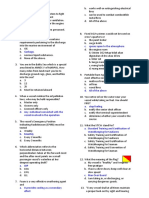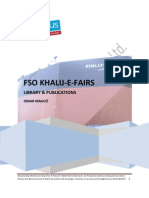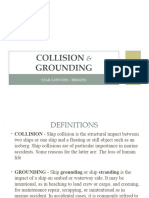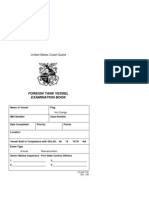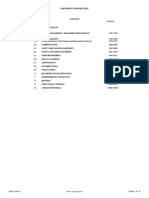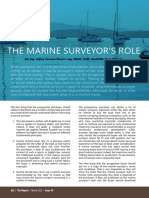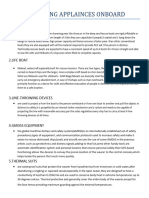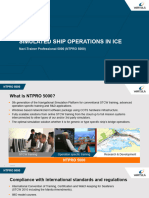Ship Shore Safety Checkllist
Ship Shore Safety Checkllist
Uploaded by
Himanshu Shekhar TiwariCopyright:
Available Formats
Ship Shore Safety Checkllist
Ship Shore Safety Checkllist
Uploaded by
Himanshu Shekhar TiwariOriginal Description:
Copyright
Available Formats
Share this document
Did you find this document useful?
Is this content inappropriate?
Copyright:
Available Formats
Ship Shore Safety Checkllist
Ship Shore Safety Checkllist
Uploaded by
Himanshu Shekhar TiwariCopyright:
Available Formats
SHIP/SHORE SAFETY CHECKLIST
Part A - Bulk Liquid General
1.
Is the ship securely moored?
2.
Are emergency towing wires correctly positioned?
3.
Is there safe access between ship and shore?
4.
Is the ship ready to move under its own power?
5.
Is there an effective deck watch in attendance on board and adequate supervision on the terminal and on the
ship?
6.
Is the agreed ship/shore communications system operative?
7.
Has the emergency signal to be used by the ship and shore been explained and understood?
8.
Have the procedures for cargo, bunker and ballast handling been agreed?
9.
Have the hazards associated with toxic substances in the cargo being handled been identified and
understood?
10.
Has the emergency shutdown procedure been agreed?
11.
Are fire hoses and fire-fighting equipment on board and ashore positioned and ready for immediate use?
12.
Are cargo and bunker hoses/arms in good condition, properly rigged and appropriate for the service intended?
13.
Are scuppers effectively plugged and drip trays in position, both on board and ashore?
14.
Are unused cargo and bunker connections properly secured with blank flanges fully bolted?
15.
Are sea and overboard discharge valves, when not in use, closed and visibly secured?
16.
Are all cargo and bunker tank lids closed?
17.
Is the agreed tank venting system being used?
18.
Has the operation of the P/V valves and/or high velocity vents been verified using the checklift testing facility,
where fitted?
19.
Are hand torches of an approved type?
20.
Are portable VHF/UHF transceivers of an approved type?
21.
Are the ships main radio transmitter aerials earthed and radars switched off?
22.
Are electric cables to portable electrical equipment disconnected from power?
23.
Are all external doors and ports in the accommodation closed?
24.
Are window type air conditioning units disconnected?
25.
Are air conditioning intakes which may permit the entry of cargo vapours closed?
26.
Are the requirements for the use of galley equipment and other cooking appliances being observed?
27.
Are smoking regulations being observed?
28.
Are naked light regulations being observed?
29.
Is there provision for an emergency escape?
30.
Are sufficient personnel on board and ashore to deal with an emergency?
31.
Are adequate insulating means in place in the ship/shore connection?
32.
Have measures been taken to ensure sufficient pumproom ventilation?
33.
Is the ship capable of closed loading, have the requirements for closed operations been agreed?
34.
Has a vapour return line been connected?
36.
Are ship emergency fire control plans located externally?
37.
Is the Inert Gas System fully operational and in good working order?
38.
Are deck seals in good working order?
39.
Are liquid levels in P/V breakers correct?
40.
Have the fixed and portable oxygen analyzers been calibrated and are they working correctly?
41.
Are fixed inert gas pressure and oxygen content recorders working?
42.
Are all cargo tank atmospheres at positive pressure with an oxygen content of 8% or less by volume?
43.
Are all the individual tank inert gas valves correctly set and locked?
44.
Are all the persons in charge of cargo operations aware that in the case of failure of the Inert Gas Plant,
discharge operations should cease, and the terminal be advised?
You might also like
- Formc MDSD FormDocument1 pageFormc MDSD FormLabLeeTravilla85% (20)
- (0415) Detailed - CBT - (E-Learning) - Report - For - Selected - PersonDocument1 page(0415) Detailed - CBT - (E-Learning) - Report - For - Selected - PersonVitalii MialykNo ratings yet
- NP 024 Black Sea and Sea of Azhov Pilot (6th Edition 2019)Document353 pagesNP 024 Black Sea and Sea of Azhov Pilot (6th Edition 2019)Alex100% (3)
- FDN - Dutch Floating BreakwatersDocument6 pagesFDN - Dutch Floating BreakwatersnikifNo ratings yet
- 2.0 PSSR - Rev 09 - Handout JULY 2020Document88 pages2.0 PSSR - Rev 09 - Handout JULY 2020sahil sakhuja100% (1)
- IACS Rec - No.76 - Temporary RepairsDocument1 pageIACS Rec - No.76 - Temporary RepairsdanielNo ratings yet
- Soal PertaminaDocument4 pagesSoal PertaminaRio Cahyo PratamaNo ratings yet
- Code of Safe Working Practices for Merchant Seafarers: Consolidated edition (incorporating amendments 1-6)From EverandCode of Safe Working Practices for Merchant Seafarers: Consolidated edition (incorporating amendments 1-6)No ratings yet
- COSWP-Enclosed SpaceDocument67 pagesCOSWP-Enclosed SpaceVladimer AcainNo ratings yet
- Carring Fishmeal CargoDocument5 pagesCarring Fishmeal CargoAndrija BoskovicNo ratings yet
- AVCS User GuideDocument15 pagesAVCS User Guidecallsignromeo007No ratings yet
- Hand Book of Establishment of Hight Speed Craft OperationDocument40 pagesHand Book of Establishment of Hight Speed Craft OperationRogerio GuahyNo ratings yet
- 2007 BP Shipping - High-Risk-Observation ListDocument9 pages2007 BP Shipping - High-Risk-Observation ListPhuong Chu BaNo ratings yet
- Pub Flag State RequirementsDocument14 pagesPub Flag State RequirementsOmar F. Mauco100% (1)
- Enhanced Survey Programme in DetailDocument16 pagesEnhanced Survey Programme in Detailvigneshiphone30100% (1)
- Guidelines For A Structure of An Integrated System of Contingency Planning For Shipboard EmergenciesDocument24 pagesGuidelines For A Structure of An Integrated System of Contingency Planning For Shipboard Emergenciesapi-3719613No ratings yet
- CatalogueDocument113 pagesCatalogueuluckptNo ratings yet
- Tankers IsgotDocument2 pagesTankers IsgotCosmin PetrescuNo ratings yet
- IMSBC Code Chart 2014-01-17Document1 pageIMSBC Code Chart 2014-01-17giannis2No ratings yet
- Arklow Meadow ReportDocument39 pagesArklow Meadow ReportMona TrunajayaNo ratings yet
- Notes - Safety and Maintenance For ph1Document59 pagesNotes - Safety and Maintenance For ph1Shashank GuptaNo ratings yet
- Ectc Guide e AbsDocument7 pagesEctc Guide e AbsCanumalla RamkumarNo ratings yet
- Timber Deck CargoesDocument70 pagesTimber Deck CargoesPratap Singh Rathore KinsariyaNo ratings yet
- Collision & GroundingDocument12 pagesCollision & GroundingAiro Nikko SolpicoNo ratings yet
- BWM Electrolysis TypeDocument4 pagesBWM Electrolysis TypeAldo Sitorus100% (1)
- MEPC.1-Circ. 881Document2 pagesMEPC.1-Circ. 881syrhaNo ratings yet
- HydrometersDocument2 pagesHydrometersashwin devaliya100% (1)
- Ultrasonic Watertight Integrity TesterDocument10 pagesUltrasonic Watertight Integrity Testergustavosese0% (1)
- EEBD Solas+GuidelinesDocument6 pagesEEBD Solas+GuidelinesIrdam Jono100% (1)
- Student Handout - Advanced Gas Tanker TrainingDocument138 pagesStudent Handout - Advanced Gas Tanker TrainingDeekshith rai100% (1)
- Pollution PortDocument49 pagesPollution PortCorto MalteseNo ratings yet
- Chemical TankerDocument10 pagesChemical TankerSIDDHARTH MOHANTYNo ratings yet
- 14.incineration12 02 08Document15 pages14.incineration12 02 08nilakhan456790100% (1)
- Foreign Tank Vessel Exam BookDocument53 pagesForeign Tank Vessel Exam BookFernando Angulo DelgadoNo ratings yet
- Unit06 - Cargo Damage ClaimsDocument6 pagesUnit06 - Cargo Damage ClaimsFouad OuazzaniNo ratings yet
- HTTP WWW - Fosfa.org Newpath LINKED - FosfaDocument6 pagesHTTP WWW - Fosfa.org Newpath LINKED - FosfaKarim MoussaNo ratings yet
- WEEK 10 - 12 Contingency Plans For Response To EmergenciesDocument20 pagesWEEK 10 - 12 Contingency Plans For Response To EmergenciesDrei Sal100% (1)
- Ship To Ship Transfer ManualDocument55 pagesShip To Ship Transfer ManualScribdTranslations100% (1)
- Grain Cargo Care ChecklistDocument5 pagesGrain Cargo Care ChecklistEfren RojasNo ratings yet
- MSD252LGC - Liquefied Gas Carrier Safety Inspection FormDocument3 pagesMSD252LGC - Liquefied Gas Carrier Safety Inspection FormcatalinNo ratings yet
- IMO Resolution A.1050Document13 pagesIMO Resolution A.1050Muhammed Salih SiracNo ratings yet
- MN-5-034-3 Safety Checklist SOLAS PDFDocument7 pagesMN-5-034-3 Safety Checklist SOLAS PDFJose Manuel Baldor GutierrezNo ratings yet
- Buoys-Dolphins 0 RotterdamDocument2 pagesBuoys-Dolphins 0 RotterdamVisveswaran InbasekaranNo ratings yet
- A STUDY ON CONTAINER CARGO OPERATION AND MOVEMENTS IN PSA TERMINAL PORT (With Table of Contents) Dheeraj 2Document89 pagesA STUDY ON CONTAINER CARGO OPERATION AND MOVEMENTS IN PSA TERMINAL PORT (With Table of Contents) Dheeraj 2Dheeraj SandyNo ratings yet
- What Is Ship Oil Pollution Emergency PlanDocument2 pagesWhat Is Ship Oil Pollution Emergency PlanMyat Kaung50% (2)
- Interim Industry Transit Advice Red Sea 2023 - 12Document2 pagesInterim Industry Transit Advice Red Sea 2023 - 12nisaNo ratings yet
- IACS Technical BackgroudDocument552 pagesIACS Technical BackgroudSeong Ju KangNo ratings yet
- rightship上船前培训课件(中英文)培训部Document52 pagesrightship上船前培训课件(中英文)培训部Steven Tan100% (1)
- Cargo Advice - Soya BeansDocument5 pagesCargo Advice - Soya Beansjim100% (1)
- D.G Ov .Au: 5.0 Emergency ResponseDocument7 pagesD.G Ov .Au: 5.0 Emergency ResponseNgaire TaylorNo ratings yet
- Bulk Carrier Inpsection EngDocument10 pagesBulk Carrier Inpsection EngAji ArnowoNo ratings yet
- Carpet Numerical and Cargo PlanDocument20 pagesCarpet Numerical and Cargo PlanAruneeka Bist100% (1)
- The Marine Surveyors Role 2Document8 pagesThe Marine Surveyors Role 2med yazidNo ratings yet
- Marine Cargo Operations MCAO1010 Course Notes Tankers - Cargo Equipment (Basic)Document12 pagesMarine Cargo Operations MCAO1010 Course Notes Tankers - Cargo Equipment (Basic)sukhjit78No ratings yet
- IMO PSC Guidelines For Marpol Annex VIDocument15 pagesIMO PSC Guidelines For Marpol Annex VIch3g44No ratings yet
- Chief Engineer's Standing Instructions.Document3 pagesChief Engineer's Standing Instructions.prashant manhasNo ratings yet
- DSME VLCC CrosstielessDocument1 pageDSME VLCC Crosstielesssilidiri100% (1)
- Hatch Covers: Key Parts & Their FunctionDocument31 pagesHatch Covers: Key Parts & Their Functionharsha_nwnNo ratings yet
- Ship Energy Efficiency Management Plan - Mepc 213 - 63 - SummaryDocument2 pagesShip Energy Efficiency Management Plan - Mepc 213 - 63 - SummaryV S Ramesh RaoNo ratings yet
- Fishmeal Cargoes Self HeatingDocument5 pagesFishmeal Cargoes Self HeatingDante Lertora BavestrelloNo ratings yet
- Sa004 Fixed Co2 Fire Fighting Systems PDFDocument1 pageSa004 Fixed Co2 Fire Fighting Systems PDFHocine TouatiNo ratings yet
- RightShip Questionnaire PDFDocument2 pagesRightShip Questionnaire PDFAks MarinerNo ratings yet
- Code of Safe Working Practices for Merchant Seafarers Consolidated 2015 edition, including amendments 1-7From EverandCode of Safe Working Practices for Merchant Seafarers Consolidated 2015 edition, including amendments 1-7No ratings yet
- The Dover Strait TrafficDocument18 pagesThe Dover Strait TraffickhanohgNo ratings yet
- A Salty DogDocument2 pagesA Salty DogRuth Vause100% (1)
- 3O - Adi Rajab AlangDocument2 pages3O - Adi Rajab AlangRejeki NomplokNo ratings yet
- Assignment 1Document1 pageAssignment 1Mark SaramillasNo ratings yet
- 04 Load Line Reissue PDFDocument4 pages04 Load Line Reissue PDFNevzat AlkoçNo ratings yet
- MARINO WORLD MAGAZINE July-August IssueDocument52 pagesMARINO WORLD MAGAZINE July-August IssueNhal LopezNo ratings yet
- Asm Questions With Answers For Dec'10 Month Version 1Document32 pagesAsm Questions With Answers For Dec'10 Month Version 1Chetan Likhite100% (4)
- Ni 617 July 2014 PDFDocument46 pagesNi 617 July 2014 PDFTi AnnelNo ratings yet
- An Analysis of Price Disparity: Peninsular Malaysia and SabahDocument14 pagesAn Analysis of Price Disparity: Peninsular Malaysia and Sabahezaid ZamNo ratings yet
- The Raiders of The Sulu Sea Film ReportDocument48 pagesThe Raiders of The Sulu Sea Film ReportRemy Rose Letran0% (1)
- IMO - BCH Code - 1994 PDFDocument86 pagesIMO - BCH Code - 1994 PDFAlex KulikNo ratings yet
- Gelmond 1 BV Ballast Water Manag Certif Till 23.02.2026Document4 pagesGelmond 1 BV Ballast Water Manag Certif Till 23.02.2026Space-Karel KarelNo ratings yet
- Rotterdam - DoverDocument6 pagesRotterdam - DoverrrpympfppsNo ratings yet
- In The Kingdom of IceDocument12 pagesIn The Kingdom of Icewamu885No ratings yet
- Pertamina Vetting Application FormDocument1 pagePertamina Vetting Application FormbatejolloroNo ratings yet
- Tandem Loading Guidelines: 3rd EditionDocument129 pagesTandem Loading Guidelines: 3rd EditionFlying DutchmanNo ratings yet
- The Maritime Executive - Nov-Dec 2010Document76 pagesThe Maritime Executive - Nov-Dec 2010Maritime ExecutiveNo ratings yet
- 3.2 Gisis - For Unlocode - 22 April 2015 - As Sent To UneceDocument29 pages3.2 Gisis - For Unlocode - 22 April 2015 - As Sent To UneceVicente MirandaNo ratings yet
- Model Course7 02Document287 pagesModel Course7 02Ricardo Ahumada HenNo ratings yet
- VGPDocument506 pagesVGPGamalMahran100% (2)
- Tanker ManualDocument205 pagesTanker ManualIuri Dudinov100% (1)
- Zoom Session Week 12 1. Read and Answer The Following Questions Before Our Zoom Session This WeekDocument3 pagesZoom Session Week 12 1. Read and Answer The Following Questions Before Our Zoom Session This WeekMaria Camila GonzalezNo ratings yet
- Pracovní List LondonDocument2 pagesPracovní List LondonJakub BaxantNo ratings yet
- Rigging The Weta TrimaranDocument6 pagesRigging The Weta TrimaranunforyoppableNo ratings yet
- ICE-Navigational Simulator - NTPRO 5000 - 2018.10Document18 pagesICE-Navigational Simulator - NTPRO 5000 - 2018.10Davor ŠvastNo ratings yet







